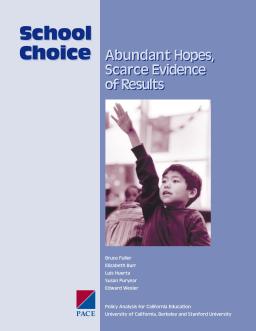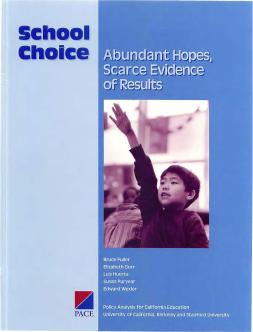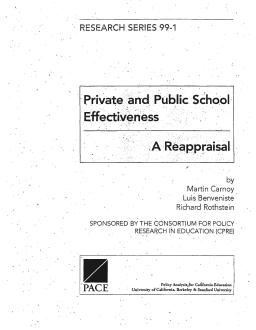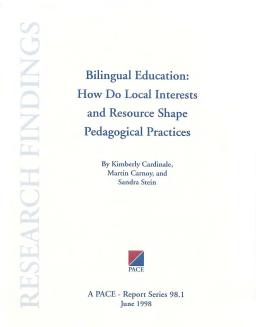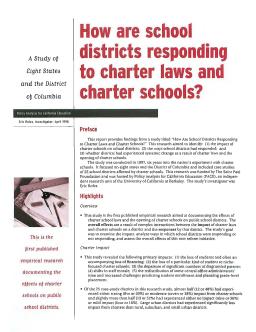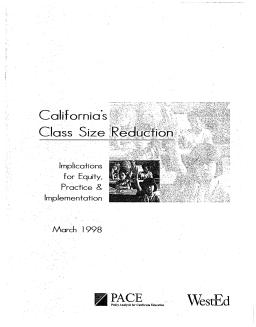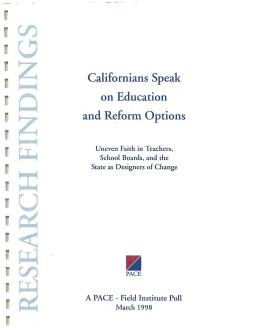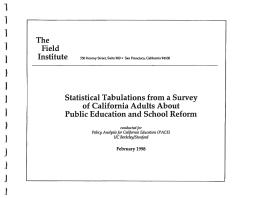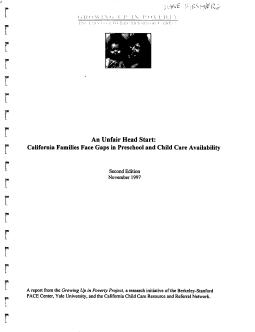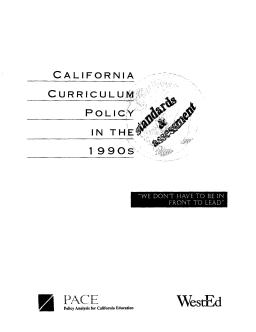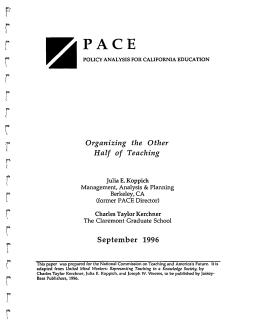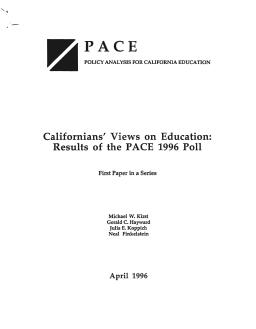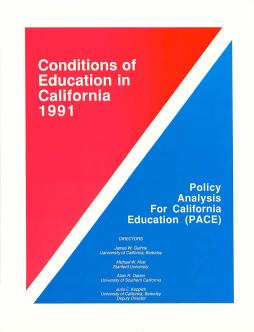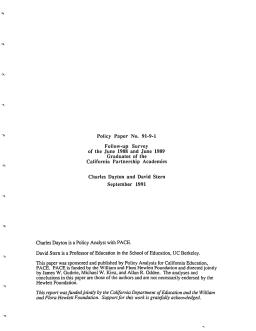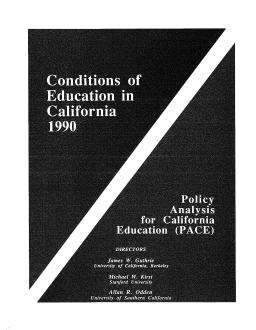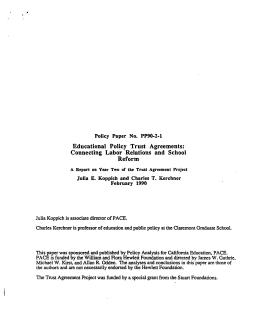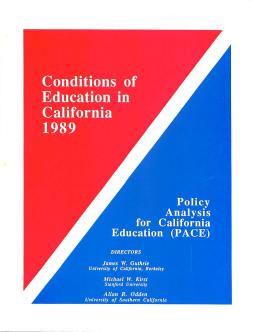Abundant Hopes, Scarce Evidence of Results—Executive Summary
Published
Summary
Public education in the US is widely criticized and everyone wants to reform it, but there's no consensus on the best strategy for improvement. This report focuses on school choice, a reform avenue gaining steam in California and the US, to explore policies and institutional changes that can boost children's learning.
Abundant Hopes, Scarce Evidence of Results
Published
Summary
Public education receives criticism from various stakeholders. Despite satisfaction with local elementary schools, overall quality concerns prevail. There is no consensus on the best approach to improve schools. PACE report investigates school choice, which is a reform strategy gaining popularity in California and beyond.
A Reappraisal
Published
Summary
This report challenges the belief that public schools are ineffective due to a lack of accountability for producing high academic achievement. Some argue that private management is necessary for improvement, but this report seeks to analyze the range of responses that schools have to accountability and determine whether market forces are necessary for improvement.
How Do Local Interests and Resources Shape Pedagogical Practices?
Published
Summary
Bilingual education implementation varies by district due to discourse and policies. Four issues affecting implementation are teacher recruitment, "ghettoization" of bilingual education, race relations, and community consensus. National debates impact local administrative actions, defining bilingual education practice. The report analyzed four California school districts to show the impact of these four issues on program design.
A Study of Eight States and the District of Columbia
Published
Summary
This report presents the results of a study investigating the impact of charter schools on school districts, how they responded, and whether they experienced systemic change due to charter laws. The study focused on eight US states and the District of Columbia and included case studies of 25 affected school districts. The research was funded by The Saint Paul Foundation and conducted in 1997, six years into the charter school experiment. PACE hosted the study.
Implications for Equity, Practice, and Implementation
Published
Summary
In 1996, CA launched a $1 billion class size reduction (CSR) initiative to improve early literacy. The initiative provides $800 per student to schools reducing class size to 20 or fewer in first, second, and/or third grade, and kindergarten. CSR was funded due to a state revenue surplus and the belief that smaller classes would enhance early literacy. CA ranked second to last in national reading tests in 1994, and class sizes averaged around 28.6 students per K-3 classroom. While educators and the public show enthusiasm, the success of CSR in enhancing academic achievement is yet to be seen.
Uneven Faith in Teachers, School Boards, and the State as Designers of Change
Published
Summary
Public education quality has long been debated, worrying parents, activists, and politicians. Recent polls show it is a top concern in California and the US. Politicians and activists propose school reform, and a new election season has begun. PACE and the Field Institute surveyed 1,003 Californians in February to assess their views on education quality, trusted reformers, and evaluating major proposals. The report details key findings.
Published
Summary
This volume presents the results of a PACE survey conducted by The Field Institute among 1,003 California adults via random digit dialing. Statistical weights were developed to match the sample of California adults interviewed to known parameters of the adult population. Estimates of sampling error from results based on the overall adult public sample are +/- 3 percentage points. Other possible sources of error include differences in question wording, sequencing, or undetected errors or omissions in sampling, interviewing, or data processing. The study professionals minimized such errors.
California Families Face Gaps in Preschool and Child Care Availability
Published
Summary
This report highlights the unequal distribution of preschool and childcare opportunities in California. Despite spending $1.2 billion annually, half of preschool-age children live in households with working mothers, with enrollment dependent on income and location. Counties vary greatly in their supply, with affluent parents more likely to find preschool or childcare slots. Latino children are hit hardest, even in counties with ample supply, with supply in predominantly Latino areas half that of low-income Black or Anglo communities.
Standards and Assessments
Published
Summary
This study traces California's curriculum-related reforms in mathematics and science during the 1990s, examining the role of the California Department of Education and the state's shifting political and policy context. It analyzes the perceptions of state officials, experts, and the public and how they influenced state policy changes. The authors raise questions about problems associated with curriculum policy in California and presents policy recommendations mentioned during interviews and document analysis. The study does not assess the impact of curriculum on school practice.
Published
Summary
The 1975 Rodda Act, also known as the Education Employment Relations Act, allowed California public school teachers to collectively bargain for employment terms. Similar laws exist in 37 states based on the National Labor Relations Act. This paper advocates for transforming education labor relations to position teachers and unions as leaders in creating a 21st century education institution. The authors hope to inform discussions on improving education quality for California's 5.2 million public school students.
Results of the PACE 1996 Poll
Published
Summary
A 1996 statewide poll by PACE surveyed Californians on their views and expectations for public schools, informing policy discussions. Results revealed four broad themes and their relevance to ongoing education policy discussions, such as redesigning statewide assessments, reforming traditional school governance, providing public funds for private schools, and complex issues of local control. PACE believes public perceptions should be considered in policy discussions, although education policy should not be solely based on public opinion polls.
Published
Summary
This is the ninth edition of Conditions of Education in California. In this volume, PACE has compiled information on current critical issues in state education policy and presented them within the context of major policy developments. "Evolving Context" introduces the current issues in the state and sets the stage for the remaining chapters, which are Assessment and Achievement, Finance, Teachers and Teaching, Integrated Children's Services, Child Care and Development Services, and School-to-Work.
Published
Summary
This report provides an overview of private schools in California as of 1992–1993, examining their enrollment, types, size, geographic distribution, and regulatory environment. It also considers how existing private schools might respond to increased demand if Proposition 174 —a school voucher initiative—were enacted. Under Proposition 174, private schools enrolling 25 or more students and meeting existing legal requirements could redeem vouchers for tuition payments. Private schools enrolled nearly 10 percent of California’s K–12 students, with approximately 554,000 students attending 3,839...
Published
Summary
The seventh edition of Conditions of Education in California by PACE focuses on education policy issues in a national context. The report analyzes California's education data by placing it in multi-state, national, and international contexts. The report's first three chapters analyze evolving education policy issues, Sacramento political dynamics, and student achievement. The remaining three chapters provide longitudinal data on student enrollment, finance, and system characteristics. The report aims to provide a continuing picture of education in California.
Published
Summary
This study compares the post-secondary experiences of graduates from California Partnership Academies with their matched comparison groups. The findings show that Academy graduates are doing equally well as comparison students in the first year or two after graduation, indicating that Academy programs have not achieved higher graduation rates at the expense of lower success rates after high school. However, there may be more subtle differences between the two groups that are not detectable by simple measures.
Published
Summary
CA's education system is affected by external factors like shifting demographics, declining economics, and intensifying politics, limiting the traditional routes of local decision-making and property taxation. Although some districts show excellence and commitment, creating and sustaining a statewide education system to meet 21st-century expectations is difficult without a comprehensive reform plan. Political conflict over revenue earmarking and school reform distracts from education improvement. This report describes and analyzes these issues, suggesting a comprehensive set of solutions.
Connecting Labor Relations and School Reform: A Report on Year Two of the Trust Agreement Project
Published
Summary
The Trust Agreement Project, initiated in September 1987, is a joint effort of 12 California school districts and their teachers' unions. It enables teachers and school management to develop agreements on professional issues beyond the traditional scope of collective bargaining. The agreements cover topics like teacher evaluation and curriculum development, and aim to enhance educational capacity by promoting collective responsibility for educational processes and outcomes. The project appears to be altering decision-making processes and encouraging collaboration between unions and management.
Published
Summary
This report examines the pervasive racial disparities in California's school discipline system, with a focus on the disproportionate suspension and expulsion of Black students, particularly Black males. Drawing from 1980s statewide data and court cases such as Larry P. and Watson v. Stockton, it documents patterns of overrepresentation in both special education placements and disciplinary actions. The report highlights how systemic bias—embedded in subjective referral categories like "willful defiance"—has led to significant exclusion of Black students from mainstream classrooms, perpetuating...
